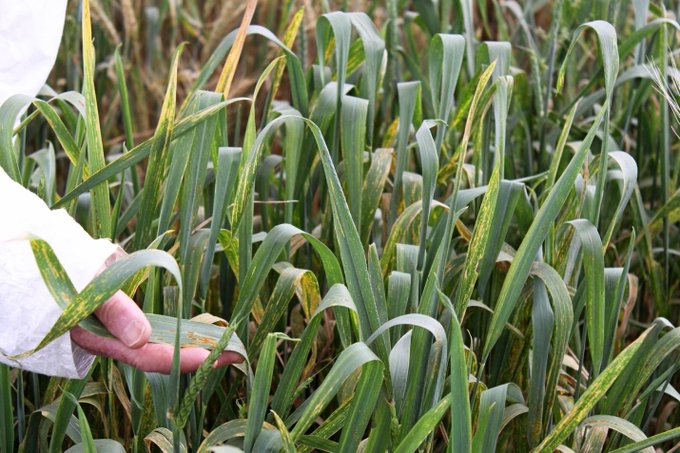|
Getting your Trinity Audio player ready…
|
The agricultural impact of climate change would be a little more straightforward if it occurred in a world where crops were free of their microbes. Research published today has found that in this hypothetical landscape, rising global temperatures will boost global agricultural productivity, partly by opening up new arable lands near the poles that were once too frigid for farming.
But this outcome is oversimplified, says study author Dan Bebber, an ecologist at the University of Exeter in the U.K. Global warming will also increase the spread of plant diseases, according to results published in the same study in Nature Climate Change. These plant pathogens may undermine any potential crop yield increases that arise from climate change.
Most modelling studies so far have focused on the impact of climate change on agricultural produce sans their microbial squatters. Bebber and his colleagues mapped the distribution of 80 species of virulent fungi and oomycetes—organisms known as “water molds” that cause blights and rots.
“One of the things that’s missing [from existing crop models] is the biological component—the pests, pathogens,” says Bebber. “One of our long-term aims is to start building in a pathogen component … so we have a better appreciation of what the future might look like.”
The study provides the most comprehensive bird’s-eye view of pathogen proliferation yet, says Jeremy Burdon, a retired evolutionary biologist at the Commonwealth Scientific and Industrial Research Organization (CSIRO) in Australia who wasn’t involved in the study. “This paper, I would argue, is a very important and valuable contribution to … understanding the interaction between crops and their pathogens.”
Plant diseases are one of the leading causes of crop failures worldwide. Pests and pathogens inflict an estimated 10 to 40 percent of agricultural losses in five of the world’s most important crops, such as wheat and rice. History is pockmarked with accounts of mass starvations incurred by plant diseases, such as the Irish potato famine in the 19th century and the 1943 Bengal famine in India that was precipitated by rice crop failure. Presently, the sunny Cavendish banana variety that graces grocery stores is on the brink of disaster due to a spreading fungus.
To extrapolate pathogens’ collective threat to humanity’s agricultural future in the face of climate change, Bebber and colleagues applied four different climate models and three crop models. The researchers first compared the projected yields of 12 species of crops between 2011 and 2030, and 2061 and 2080. The models predicted more bountiful harvests at higher latitude for all crops, ranging from sugar beet to pea to soybean, while regions closer to the equator would experience either modest yield increases or declines. Overall, the results showed climate change spells higher agricultural productivity for the entire planet.
But adding pathogens into the picture paints a grimmer scenario. To do so, the researchers combed through published field data on the temperature tolerances of fungal and oomycete pathogens. Then they computed each pathogen’s risk of infecting crops based on the predicted temperatures. According to the calculations, as the frontier of arable lands creep poleward, pathogens that were once sequestered in the warmer zones follow. Thanks to climate change, countries seated closer to the poles will eventually become conducive enough for more pathogens to settle in and wreak havoc on crops. Not only will crops further north and south be more susceptible to new infections than their equatorial counterparts, a wider variety of malignant microbes will also be more likely to pop up nearer the poles.
For now, Bebber’s team can’t predict crop yield numbers from the pathogenic infection rates, because the same pathogenic strain may behave unpredictably on different soils. He gives the example of the sudden oak death pathogen—it decimated oak populations on the U.S. West Coast, but left British oaks untouched; instead, it went after the Japanese larch trees in the U.K. Moreover, the researchers only looked at temperature as the sole driver for pathogen spread; but the reality depends on a concoction of factors, including the local changes in rainfall, a community’s readiness to combat new diseases and shifts in farmers’ choice of crops in the future.
In the maw of climate change, local farmers in developing countries closer to the tropics may suffer more than others, says Camille Parmesan, a climate change biologist at the French National Centre for Scientific Research who didn’t participate in the study. “Those people are already really getting hit very hard,” she says. These growers may not be prepared to deal with the new suite of pathogens due to poverty and outdated farming practices. And these local farmers may not be able to afford to import food from the global north or south. “They can’t just suddenly be buying food from Canada,” she says.
In the future, society needs to focus on tackling crop losses to reduce the environmental footprint of agriculture, say Bebber. Agriculture is the second largest producer of climate emissions in the world, only after the energy sector. “Tackling pests and diseases is one way of making agriculture more efficient,” he says. However, reining in the spread of parasites will be complicated. Common strategies often come with the knock-on effects, such as increased fungal resistance from fungicide overuse. “Societies have to make decisions about the disease [and] pest control—what people are willing to spend and how to do it,” he says.
Source: Smithsonian Magazine
